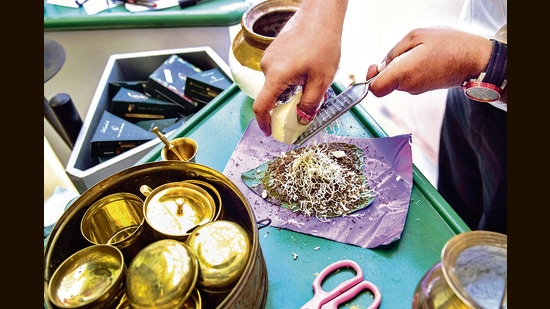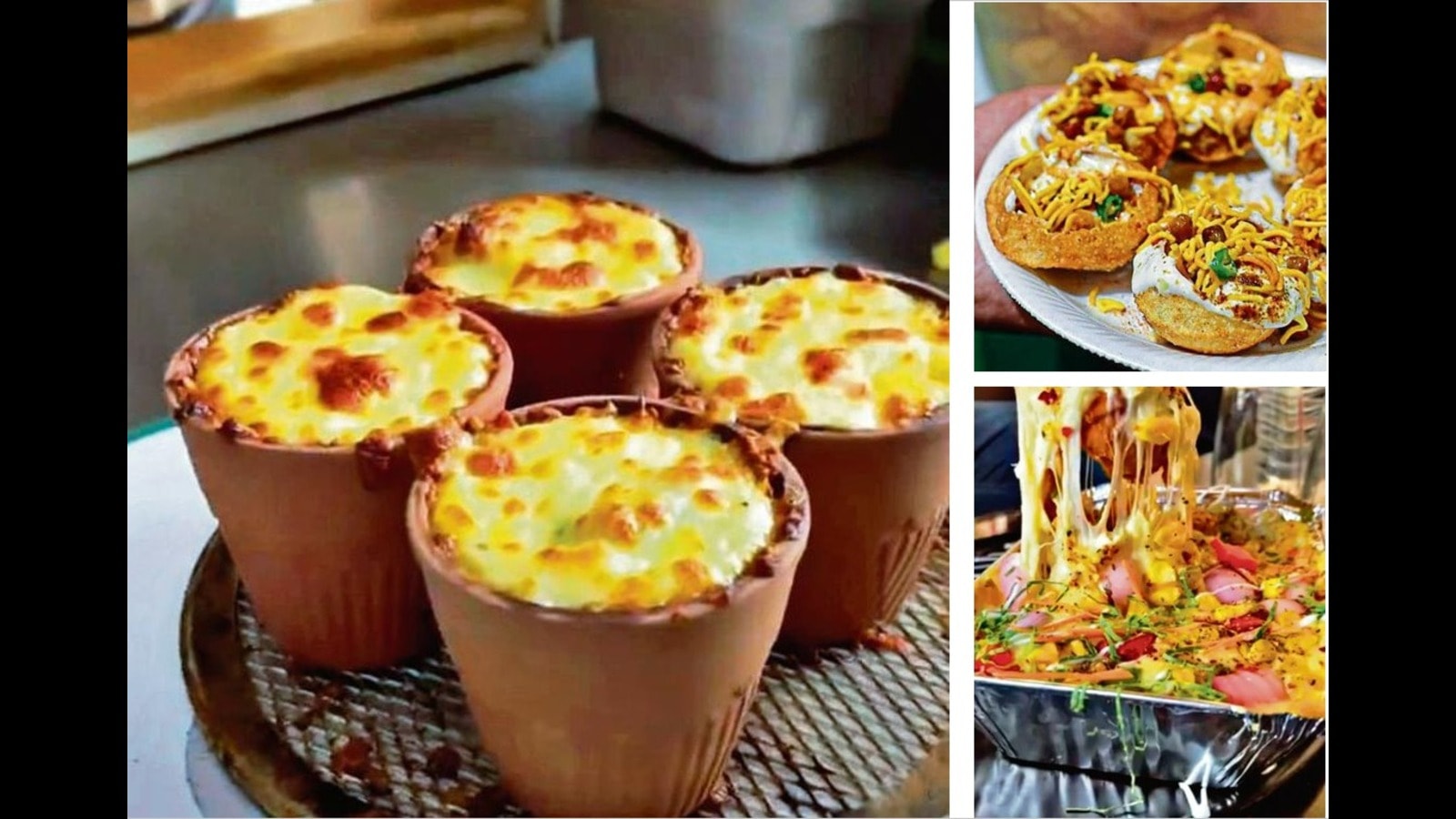It’s snowing sticky white flakes on the streets of Mumbai and Vadodara, Ahmedabad, Prayagraj, Lucknow, Kolkata… across the country, cities are in the grip of a cheese explosion.
It started with the sandwiches and dosas, in the 1990s. But now vendors are clearly going for shock value. A Mumbai stall offers cheese-stuffed paan. Allahabad does a cheese-pull momo pizza (deep-dish; baked in a tin-foil takeaway box). In Kolkata, phuchkas come with cheese grated over the top, then melted with a kitchen blowtorch. Vadodara’s Bhai Bhai Dabeli offers a mango dolly dabeli that involves bread dipped in various syrups, topped with dry fruit and a chopped-up mango dolly, then covered with grated cheese.
These recipes go back five to six years. Who eats this stuff? Why? When did the line between creativity and cringe begin to be so gleefully crossed?
Until a few years ago, the standard upgrade for a street-food snack was butter. The Mumbai eatery Sardar Pav Bhaji built its entire reputation on slabs of the stuff, which float atop unarguably plain bhaji. In Ahmedabad, vendors added generous lashings of butter to the vada pav, a trend that has since spread to the home of that snack, Mumbai.

Cheese, even the relatively affordable processed variety launched by Amul in 1959, remained a luxury, until the mid-Aughts. “That’s when the children who grew up in a liberalising India joined the workforce,” says Mumbai-based food writer Roshni Bajaj Sanghvi. In those boom years, a young workforce was earning more, spending more, and willing to experiment. These were the years, then, of the chowmein dosa, the Chinese bhel. Then social media turned adventure into an addiction.
“The past five to seven years have belonged to Instagram. The performativity of cheese-based foods — the stretchiness, meltiness, camera-friendliness — made it ideal for Stories, posts and Reels,” says Meher Varma, a Delhi-based anthropologist and host of Bad Table Manners, a podcast that explores South Asian food and food habits from an anthropological lens.
“A lot of the street-food vendors are active on Instagram too. If something clicks, they know it’s good for business,” Bajaj Sanghvi says.
Meanwhile, menus have stretched out as well; it’s one way to get culinary adventurers to return. The mango dolly dabeli, for instance, is one of 35 variations on the Bhai Bhai menu. Owner Bharat Shah says he made most of his additions in 2014.
SAY WHEN
Vendors say they put a lot of thought and research into their cheesy additions. Shah tried his mango cheese dabeli on multiple groups of customers before launching it. “The idea for a cheese-topped paan came from my daughter, Adeeba. She’s seven and loves cheese,” says Naushad Shaikh, owner of The Paan Story, Mumbai. Over numerous trials, Shaikh settled on his cheese-paan recipe, which balances out the richness and saltiness of the processed cheese with shavings of chocolate.
The drama, richness and value-for-money of the added cheese are also one way to compete with sit-down eateries and fast-food chains. Mumbai’s Pure Milk & Snacks Centre, for instance, has a “cheese-burst” dish of bubbling cream cheese poured over rolled-up dosas that is clearly competing with the city’s popular but expensive pizza-delivery chains.
While Amul’s blocks of processed cheese are still popular with these vendors, brands such as Dilkhush, Gowardhan and Veeba have caught on and now offer powdered, diced and liquid cream cheese that’s quicker and less labour-intensive to use. (Gowardhan launched its shredded cheese in 2011.)
For vendors looking to move volumes of their food, the white stuff is a sure shot. Add “cheese”, “cheesy”, “cheese-and-chilli” to an item’s description and it begins to fly off the grill, they say. A few rupees worth of the stuff also allows them to charge more, for an item that seems like more value for money, and offers the hit of salt and fat that can keep diners coming back.
Just grating or pouring the stuff on top isn’t as newsworthy, though. So recipes are evolving. Recent trend-setters include Chirag Kalvani of the Surat-based The Cone Chaat, inventor of the kulhad pizza; and Akshay Agarwal of Mumbai’s Om Snacks, home of the Hulk sandwich.
“We created Hulk in 2018 to have something on the menu that would become our USP,” says Agarwal. “People come all the way from Pune just to try it.” He’s referring to a towering five-layer preparation of vegetables, paneer and sauces, all invisible under drapings of cheese.
Kalvani, similarly, arranged breadcrumbs, vegetables, sauces, seasonings and cheese in layers, in a kulhad, and popped it in the oven, to create a gooey dish dominated by cheese. This was at the start of the pandemic, when business was slow and he decided to use the time to innovate. His kulhad pizza is so popular, partly thanks to viral Instagram Reels of it, that he recently leased a spot in Mumbai and plans to open up in that city by Diwali.
“Every generation tends to be a bit more experimental with street food than the previous one and the current trends are being defined by Gen Z, who want to be influencers and do something new, whether it’s in the areas of fashion, dance or food,” says Bajaj Sanghvi. “So most street food vendors now have these one or two dishes that they know can go viral.”
No cheese pull lasts forever, though. So what’s next? One trend that fast fizzled out is the Sherbet Maggi (instant noodles cooked with rose syrup, orange cola, chocolate sauce or ice-cream). Pani puri is starting to go vertical; the Bahubali golgappa could catch on next. Golas (the streetside ice lollies) are showing signs of going the freakshake way.
For now, though, the cheese remains stuck to the pan. Even chefs that would rather not go that route say they are succumbing. Aditi Keni, Mumbai-based consultant chef and chief of product at Boombay sauces, says she “had to add” a chilli-cheese tikka and cheese-corn samosa to the menu at her restaurant Kebabchi, in Jamshedpur, because diners kept asking for “something cheesy”. “I had intended to stick to just kebabs,” she says.
Enjoy unlimited digital access with HT Premium
Subscribe Now to continue reading
Stay connected with us on social media platform for instant update click here to join our Twitter, & Facebook
We are now on Telegram. Click here to join our channel (@TechiUpdate) and stay updated with the latest Technology headlines.
For all the latest Art-Culture News Click Here

